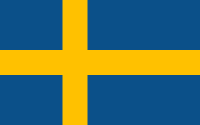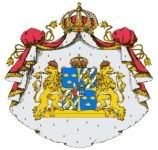Sweden
From Kaiserreich
Sweden, officially the Kingdom of Sweden (Konungariket Sverige in Swedish) It borders Norway to the west, Finland to the east and Denmark to the south.
| ||||||
| Motto Med folket för fosterlandet (With the people for the Fatherland) | ||||||

| ||||||
| Anthem Du Gamla, Du fria | ||||||
|
| ||||||
| Official Language | Swedish | |||||
| Capital | Stockholm | |||||
| Head of State | Gustav V | |||||
| Head of government | Per Albin Hansson | |||||
| Establishment | Prehistoric | |||||
| Government | Constitutional Monarchy | |||||
| Currency | Swedish krona | |||||
| Area | ca. 450.000 km^2 | |||||
| Population | 6,266,888 | |||||
Swedish Empire
The seventeenth century saw the rise of Sweden as one of the Great Powers in Europe. Sweden also had colonial possessions as a minor colonial Empire that existed from 1638-1663 and later 1785-1878.
Sweden was during Imperial times the most powerful country of northern Europe and the Baltic Sea. Sweden's Imperial status took its start with Gustav II Adolph as king, and his successful participation in the Thirty Years' War, which made Sweden the recognized leader of Continental Protestantism in Europe until 1721 when the Empire collapsed.[citation needed] Sweden's Imperial status during this period is largely credited to Gustav I's major changes on the Swedish economy in the mid-1500s, and his introduction of Protestantism.
The mid 1600s and the early 1700s were Sweden's most successful years as a Great Power. Sweden reached its largest territorial extent during the rule of Charles X (1622-1660) after the treaty of Roskilde in 1658. However, after more than a half century of almost constant warfare the Swedish economy had deteriorated. It would become the lifetime task of Charles' son, Charles XI (1655-1697), to rebuild the economy and refit the army. His legacy to his son, the coming ruler of Sweden Charles XII, was one of the finest arsenals in the world, a large standing army and a great fleet. Sweden's largest threat at this time, Russia, had a larger army but was far behind in both equipment and training. The Swedish army crushed the Russians at the Battle of Narva in 1700, one of the first battles of the Great Northern War. This led to an overambitious campaign against Russia in 1707, however, ending in a decisive Russian victory at the Battle of Poltava in 1709. The campaign had a successful opening for Sweden, which came to occupy half of Poland and making Charles able to claim the Polish throne. But after a long march exposed by cossack raids, the Russian Tsar Peter the Great's scorched-earth techniques and the cold Russian climate, the Swedes stood weakened with a shattered confidence, and enormously outnumbered against the Russian army at Poltava. The defeat meant the beginning of the end for Sweden as Empire.
Even though Sweden had lost almost half of its army during these times of intense war, Charles XII still attempted to invade Norway 1716. Soundly defeated in the war, the Swedish head of state signed the Treaty of Nystad in 1721. Forced to cede large areas of land, Sweden also lost its place as an empire and as the dominant state on the Baltic Sea. With Sweden's lost influence, Russia began to emerge as an empire, and become one of Europe's dominant nations.
In the eighteenth century, Sweden did not have enough resources to maintain its territories outside Scandinavia and most of them were lost, culminating with the 1809 loss of the territory once named Österland(Eastern district) and the eastern part of Norrland to Russia: these parts became the semi-autonomous (Duchy) of Finland of Imperial Russia.
After Denmark-Norway was defeated in the Napoleonic wars, Norway was ceded to the king of Sweden on January 14, 1814, at the Treaty of Kiel. The Norwegian attempts to keep their status as a sovereign state were rejected by the Swedish king, Charles XIII. He launched a military campaign against Norway on July 27, 1814, ending in the Convention of Moss, which forced Norway into a personal union with Sweden, which was not dissolved until 1905. The 1814 campaign was also the last war in which Sweden participated as a combatant.
Recent history
Sweden remained neutral during the Weltkrieg. It did, however, let Finnish students travel through on their way to Germany for their Jaeger training. Sweden invaded the Åland islands during the Finnish Civil War, which caused a lot of bad blood between the two nations. The crisis was solved with Germany acting as the middle-man, favouring the Finns quite openly and giving them the control of the islands. The Swedish internal policies are dominated by the question of either staying neutral in a very polarized Europe or picking a side. This, combined with neighbours that are slipping to opposing sides of a possible future conflict, means that the coming parliamentary elections might be the most important ever.


